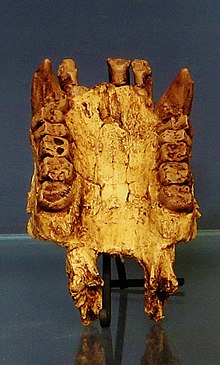Morotopithecus
| Morotopithecus | |
|---|---|

| |
| Jaw | |
| Scientific classification | |
| Domain: | Eukaryota |
| Kingdom: | Animalia |
| Phylum: | Chordata |
| Class: | Mammalia |
| Order: | Primates |
| Suborder: | Haplorhini |
| Infraorder: | Simiiformes |
| Family: | †Proconsulidae |
| Genus: | †Morotopithecus Gebo et al., 1997 |
| Species: | †M. bishopi
|
| Binomial name | |
| †Morotopithecus bishopi | |
Morotopithecus is a genus of fossil ape discovered in Miocene-age deposits of Moroto, Uganda.
The
great apes).[2] Parsimonious phylogenetic analyses indicate Morotopithecus is more derived than Proconsul,[3] Afropithecus, and Kenyapithecus, but less derived than Oreopithecus, Sivapithecus, and Dryopithecus. Under this arrangement, Morotopithecus would be a sister taxon to extant great apes while Hylobates (gibbons) seem to have branched off before this clade appeared. However, gibbons are believed to have branched off 18 million years ago while Morotopithecus is dated to more than 20.6 million years.[4]
In a comparison of teeth characteristics of Morotopithecus to Ugandapithecus, and considered Morotopithecus synonymous with Afropithecus.[6]
It appears to have lived in wooded grassland, and had a diet dominated by leaves.[7]
References
- PMID 9103195. Archived from the original on November 10, 2021.)
{{cite journal}}: CS1 maint: multiple names: authors list (link - PMID 17925867.
- from the original on November 14, 2023.
- PMID 14871561.
- PMID 16914180.
- .
- ^ "Early Apes Lived on Savannas, Not in Forests". Smithsonian Magazine. Archived from the original on October 25, 2023.
Further reading
- Page, Michael Le (2023-04-13). "Early break-up of eastern African forests shaped our ape ancestors". New Scientist. Archived from the original on September 30, 2023. Retrieved 2024-02-13.
